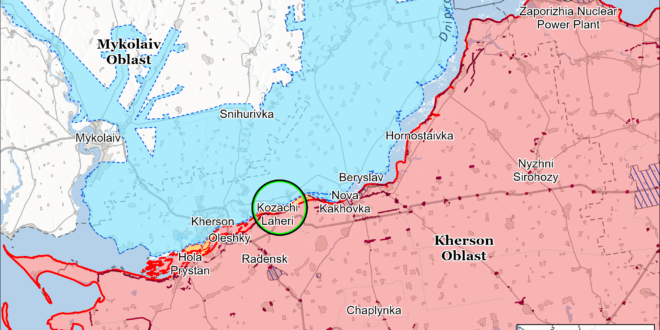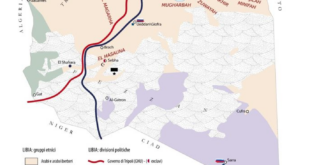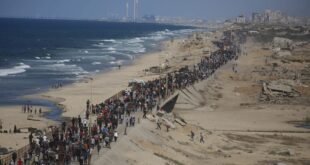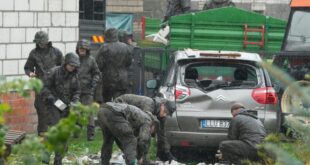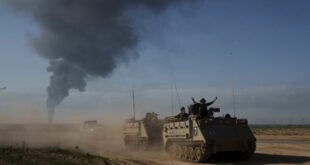Note: The data cut-off for this product was 11:45am ET on April 17. ISW will cover subsequent reports in the April 18 Russian Offensive Campaign Assessment.
Russian officials continue to reiterate Russian President Vladimir Putin’s non-negotiable demands for extensive territorial concessions from Ukraine while noting that ongoing peace negotiations are unlikely to achieve results quickly. Kremlin Spokesperson Dmitry Peskov claimed on April 17 that negotiations regarding Ukraine are “progressing quite difficultly,” that Ukraine and Europe are to blame for the lack of progress, and that Russia is focusing “for now” on its “contacts” with the United States.[1] Peskov responded to a question about whether recognition of the Ukrainian territories that Russia has demanded is mandatory for ending the war, claiming that these regions are “integral” parts of Russia so “it is impossible to pose the question this way.”[2] Kremlin officials continue to reiterate Putin’s demand that Ukraine cede territory — including parts of Ukraine that Russian forces do not currently occupy — to Russia while demonstrating Russia’s unwillingness to compromise on these demands.[3]
Russian forces recently conducted a roughly battalion-sized mechanized assault across a wide front in western Zaporizhia Oblast, representing an inflection in recently observed Russian mechanized assault tactics. Ukrainian military officials reported on April 17 that Ukrainian forces repelled a series of mechanized assaults by elements of the Russian 58th Combined Arms Army (CAA) (Southern Military District [SMD]) that consisted of roughly a battalion’s worth of equipment, including 320 personnel, 40 armored vehicles, three tanks, and about 10 buggies, along the Pyatykhatky-Stepove-Lobkove-Mali Shcherbaky-Mala Tokmachka line (a frontage of roughly 40 kilometers) south and southwest of Orikhiv on the evening of April 16.[4] Ukrainian military officials reported that Ukrainian forces destroyed all three Russian tanks and 29 armored vehicles and killed or wounded 140 Russian soldiers.[5] Geolocated footage of the assault indicates that Russian forces advanced along the T-0515 Orikhiv-Polohy highway south of Mala Tokmachka (southeast of Orikhiv).[6] ISW has not observed any other geolocated footage as of this writing to indicate any further advances along the wide front of attack. Ukrainian Southern Defense Forces Spokesperson Colonel Vladyslav Voloshyn reported that Russian forces conducted a similar assault in western Zaporizhia Oblast on April 13 — likely in reference to a recent Russian reinforced company-sized mechanized assault in the Zaporizhia direction.[7] Voloshyn reported that Russian forces spent months preparing for these assaults and have concentrated additional assault groups for possible future assaults. Ukrainian officials have warned of the possibility of intensified Russian offensive operations in western Zaporizhia Oblast since November 2024.[8]
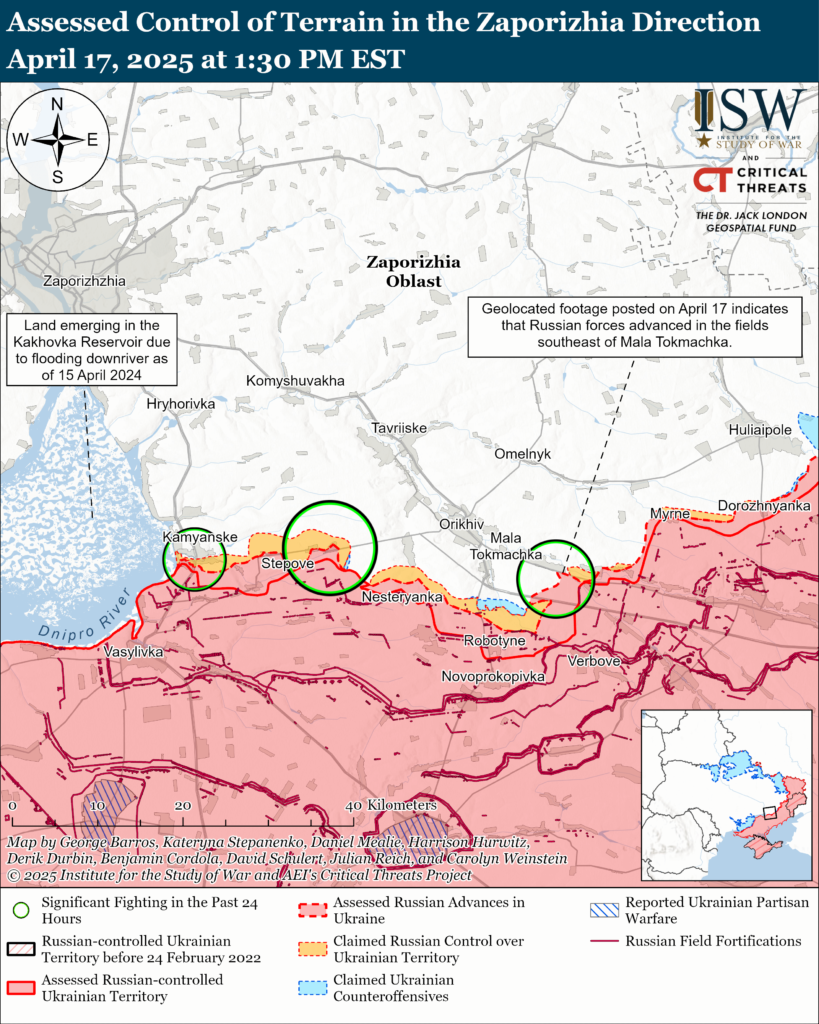
Russian forces fighting in Ukraine since 2023 do not usually conduct mechanized assaults spread out across a wide front. Russian forces typically conduct mechanized assaults in singular frontal assaults in narrower and more limited areas, likely intending to break through Ukrainian defenses with a greater concentration of forces in a single area, or as part of turning movements to outflank and envelop Ukrainian positions.[9] The tactical objective of this battalion-sized attack remains unclear, and the available footage and Ukrainian reporting indicates that Ukrainian forces defeated the attack. Russian forces may have intended for the April 16 mechanized assault to probe Ukrainian defenses to gauge the Ukrainian reaction and to detect possible weak points in Ukrainian positions ahead of future, more concentrated assaults. Elements of the 58th CAA may have been testing a different tactic, alternatively. ISW has not observed evidence to suggest that Russian forces elsewhere along the frontline recently have implemented similar mechanized assault tactics. The decision to dedicate roughly a battalion’s worth of armored vehicles to a broad mechanized assault with likely minimal gains is notable given Russia’s extensive armored vehicle losses in the war, dwindling Soviet-era armored vehicle stockpiles, and limited capacity to produce, refurbish, and repair armored vehicles.[10]
Russian forces continue to intensify their usage of armored vehicles across the frontline amid continued negotiations to end the war. Commander of the Ukrainian National Guard, Brigadier General Oleksandr Pivnenko, reported on April 17 that Ukrainian forces repelled a reinforced company-sized mechanized assault in the Pokrovsk direction and that preliminary information confirms that Ukrainian forces destroyed 21 armored fighting vehicles, two other vehicles, and 96 motorcycles and killed and wounded over 240 Russian soldiers.[11] Ukrainian President Volodymyr Zelensky stated on the evening of April 17 that Russian forces launched an attack in the Pokrovsk direction and that Ukrainian forces destroyed the entire Russian grouping consisting of 115 pieces of equipment (likely including armored vehicles, other vehicles, and motorcycles), killed 200 Russian soldiers, and wounded 30 more.[12] ISW has recently observed an increase in Russia’s use of armored vehicles throughout the theater after mainly relegating armored vehicles to fire support roles and relying on infantry assaults to advance in late 2024 and early 2025.[13] This intensification may be related to changing weather conditions and hardening terrain as Ukraine is coming out of its muddy rasputitsa season, the spring period in which melting frozen winter ground and spring rains degrade conditions for mechanized movement. This intensification may also be related to the Kremlin’s continued insistence that Ukraine cede all of Luhansk, Donetsk, Zaporizhia, and Kherson oblasts to Russia and that the four oblasts be recognized as Russian territory.[14]
The Kremlin is adopting increasingly threatening rhetoric towards Europe aimed at preventing Europe from supporting Ukraine and defending itself. Russian Ministry of Foreign Affairs (MFA) Spokesperson Maria Zakharova warned on April 17 that Russia will consider any missile strike with German Taurus missiles against Russia to be Germany’s direct participation in the war in Ukraine.[15] Zakharova also threatened Estonia, mirroring Russian Foreign Intelligence Service (SVR) Head Sergey Naryshkin’s recent threat that Poland and the Baltic States would be the “first to suffer” in the event of “NATO aggression” against Russia or Belarus.[16] The Kremlin has repeatedly used similar threats against Western states sending military aid to Ukraine as part of Russia’s wider reflexive control campaign to influence Western decision-making and deter aid to Kyiv, including nearly identical threats against the US regarding allowing Ukraine to strike Russia with ATACMS.[17] The Kremlin likely seeks to portray European efforts to augment both European and Ukrainian defensive capabilities as provocative in order to push European countries into self-deterring from providing Ukraine with additional military support and bolstering European defensive capabilities.
Russia is increasingly adapting its drones to facilitate chemical weapons strikes against the frontline and rear areas of Ukraine — in violation of the Chemical Weapons Convention (CWC), of which Russia is a signatory. Ukraine’s Southern Operational Command and Center for Countering Disinformation reported on April 16 and 17 that Ukrainian authorities identified a capsule with concentrated chlorobenzylidenemalononitrile (CS) gas, a type of riot control agent (RCA) banned under the CWC, on Russian Shahed drones and that Russia may be using these drones to disperse poisonous substances among the civilian population.[18] The Center for Countering Disinformation noted that reports that Russian forces are coating Shahed drones with poisonous substances are unconfirmed.[19] Ukrainian Donetsk Oblast Military Administration Head Vadym Filashkin similarly reported on April 16 that Russian forces had equipped Shahed drones that fell in Donetsk Oblast with capsules filled with “concentrated irritant gas.”[20] Filashkin urged Ukrainian citizens to not approach downed Shahed debris and noted that Russian forces have previously equipped Shaheds with grenades with delayed detonation mechanisms. Russian forces have reportedly extensively used CS gas in grenades dropped from drones on Ukrainian positions throughout the frontline and have reportedly equipped Shaheds with cluster munitions.[21] Ukrainian forces have proven effective at shooting down Shahed drones, and Russia likely seeks to equip Shahed drones with weapons to still cause damage even when Ukrainian forces shoot down the drones before striking their intended targets.[22] These Russian adaptations are highly likely to cause disproportionate damage to civilians, however.
Ukrainian President Volodymyr Zelensky reported that the United States and Ukraine are making progress towards signing a bilateral mineral deal. Zelensky stated on April 16 that the Ukrainian team working with the United States on the mineral deal has achieved “good results” and that the parties have almost finalized the “basic legal matters.”[23]
European countries continue to increase their domestic defense production, including in support of Ukraine. German arms manufacturer Rheinmetall CEO Armin Papperger stated on April 17 that the Rheinmetall AG Unterlub plant will produce 350,000 artillery shells in 2025 — 150,000 more than the 200,000 originally planned for 2025 — and that the company has so far invested about €600 million (roughly $682 million) in the Unterlub site.[24] Papperger stated that he expects Rheinmetall to earn €300 billion (roughly $340 billion) in sales in the next five years (until roughly 2030). The Czech engineering company PBS Group announced on April 16 that it will increase its production capacity of aircraft jet engines by 220 percent in 2025 in response to increased demand from global customers, including Ukraine.[25]
Key Takeaways:
Russian officials continue to reiterate Russian President Vladimir Putin’s non-negotiable demands for extensive territorial concessions from Ukraine while noting that ongoing peace negotiations are unlikely to achieve results quickly.
Russian forces recently conducted a roughly battalion-sized mechanized assault across a wide front in western Zaporizhia Oblast, representing an inflection in recently observed Russian mechanized assault tactics.
The Kremlin is adopting increasingly threatening rhetoric towards Europe aimed at preventing Europe from supporting Ukraine and defending itself.
Russia is increasingly adapting its drones to facilitate chemical weapons strikes against the frontline and rear areas of Ukraine — in violation of the Chemical Weapons Convention (CWC), of which Russia is a signatory.
Ukrainian President Volodymyr Zelensky reported that the United States and Ukraine are making progress towards signing a bilateral mineral deal.
European countries continue to increase their domestic defense production, including in support of Ukraine.
Ukrainian forces recently advanced near Toretsk. Russian forces recently advanced in Kursk Oblast and near Kupyansk, Toretsk, Pokrovsk, Novopavlivka, and Velyka Novosilka and in western Zaporizhia Oblast.
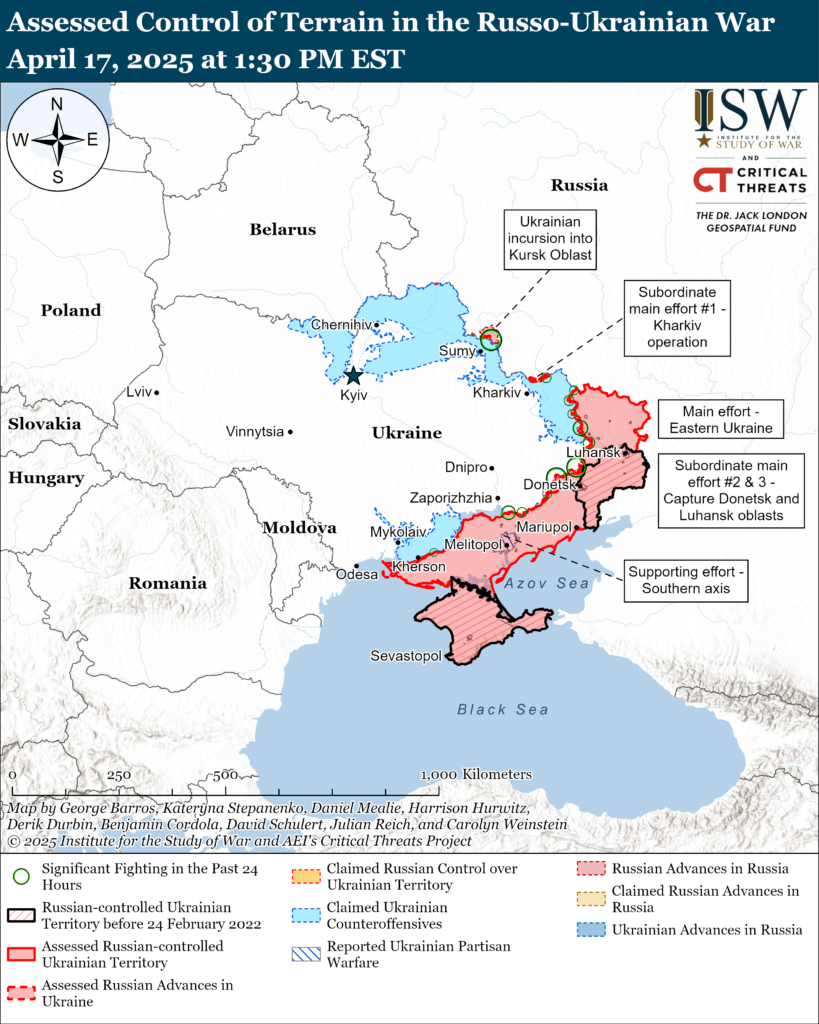
We do not report in detail on Russian war crimes because these activities are well-covered in Western media and do not directly affect the military operations we are assessing and forecasting. We will continue to evaluate and report on the effects of these criminal activities on the Ukrainian military and the Ukrainian population and specifically on combat in Ukrainian urban areas. We utterly condemn Russian violations of the laws of armed conflict and the Geneva Conventions and crimes against humanity even though we do not describe them in these reports.
Alleged Ceasefire Violation
Ukrainian Operations in the Russian Federation
Russian Supporting Effort — Northern Axis
Russian Main Effort — Eastern Ukraine (comprised of three subordinate main efforts)
Russian Subordinate Main Effort #1 — Push Ukrainian forces back from the international border with Belgorod Oblast and approach to within tube artillery range of Kharkiv City
Russian Subordinate Main Effort #2 — Capture the remainder of Luhansk Oblast and push westward into eastern Kharkiv Oblast and encircle northern Donetsk Oblast
Russian Subordinate Main Effort #3 — Capture the entirety of Donetsk Oblast, the claimed territory of Russia’s proxies in Donbas, and possibly advance into Dnipropetrovsk Oblast
Russian Supporting Effort — Southern Axis
Russian Air, Missile, and Drone Campaign
Russian Mobilization and Force Generation Efforts
Russian Technological Adaptations
Activities in Russian-occupied areas
Significant Activity in Belarus
Alleged Ceasefire Violations
Ukraine and Russia have not yet concluded a maritime ceasefire agreement due to ongoing Russian demands for Western sanctions relief. Negotiations regarding the conditions of the ceasefire on strikes against energy infrastructure are ongoing, and the resolution of these negotiations remains unclear.
The Russian Ministry of Defense (MoD) claimed without evidence on April 17 that Ukrainian forces struck energy infrastructure in Belgorod, Bryansk, Ryazan, Tver, Kursk, and Tula oblasts and Russian-occupied Zaporizhia Oblast 10 times over the past day.[26] Russian Ministry of Foreign Affairs (MFA) Spokesperson Maria Zakharova claimed on April 17 without evidence that Ukrainian forces conducted over 80 strikes against “Russian” energy facilities (including objects in Russian-occupied Ukraine) between March 18 and April 17.[27] A Russian source claimed that Ukrainian forces “deliberately” struck the Russian-occupied Zaporizhzhia Nuclear Power Plant (ZNPP) in Zaporizhia Oblast on April 17 before the end of the temporary strike ceasefire.[28] Kherson Oblast occupation head Vladimir Saldo claimed on April 17 that Ukraine violated the ceasefire 12 times in occupied Kherson Oblast and damaged solar panels, an electrical substation, and gas infrastructure.[29]
Kremlin Spokesperson Dmitry Peskov stated on April 17 that Russian President Vladimir Putin has given no new instructions regarding the ceasefire on strikes against energy facilities.[30] Peskov claimed on April 15 that the Kremlin would clarify the end date of the temporary ceasefire and that “everything will depend” on Putin’s orders.[31] ISW continues to assess that the details of the ceasefire — including its end date — remain unclear given the lack of formal, publicly-available joint ceasefire documents and that Russia may intensify its long-range strikes against Ukraine after Russia recognizes the end of the ceasefire.[32]
Ukrainian Operations in the Russian Federation
Russian forces recently advanced in Kursk Oblast.
Assessed Russian advances: Geolocated footage published on April 16 indicates that Russian forces recently seized the St. Nicholas Monastery southwest of Guyevo (south of Sudzha near the international border).[33] Some Russian milbloggers claimed that Ukrainian forces still occupy the St. Nicholas Monastery, however.[34]
Unconfirmed claims: Russian milbloggers claimed that Russian forces also advanced west, east, and southwest of the St. Nicholas Monastery.[35]
Fighting continued near Gornal (southwest of Sudzha), Oleshnya (west of Sudzha), and Guyevo on April 16 and 17.[36]
Order of Battle: Elements of the Russian 40th Naval Infantry Brigade (Pacific Fleet), including an unspecified 1st company of the brigade, are reportedly operating near the St. Nicholas Monastery.[37] Elements of the 106th Airborne (VDV) Division are reportedly operating near Oleshnya.[38]
Fighting continued in northwesternmost Belgorod Oblast on April 17, but Russian forces did not make confirmed advances.
Unconfirmed claims: Ukrainian military observer Kostyantyn Mashovets stated on April 17 that Russian forces advanced between Popovka and Demidovka (both northeast of Belgorod City).[39]
Russian milbloggers claimed that Ukrainian forces counterattacked near Popovka and Demidovka on April 16 and 17.[40]
Order of Battle: Elements of the Russian 34th Motorized Rifle Brigade (49th Combined Arms Army [CAA], Southern Military District [SMD]) are reportedly operating near Popovka.[41] Drone operators of the 128th Motorized Rifle Brigade (44th Army Corps [AC], Leningrad Military District [LMD]) are reportedly operating near Popovka.[42]
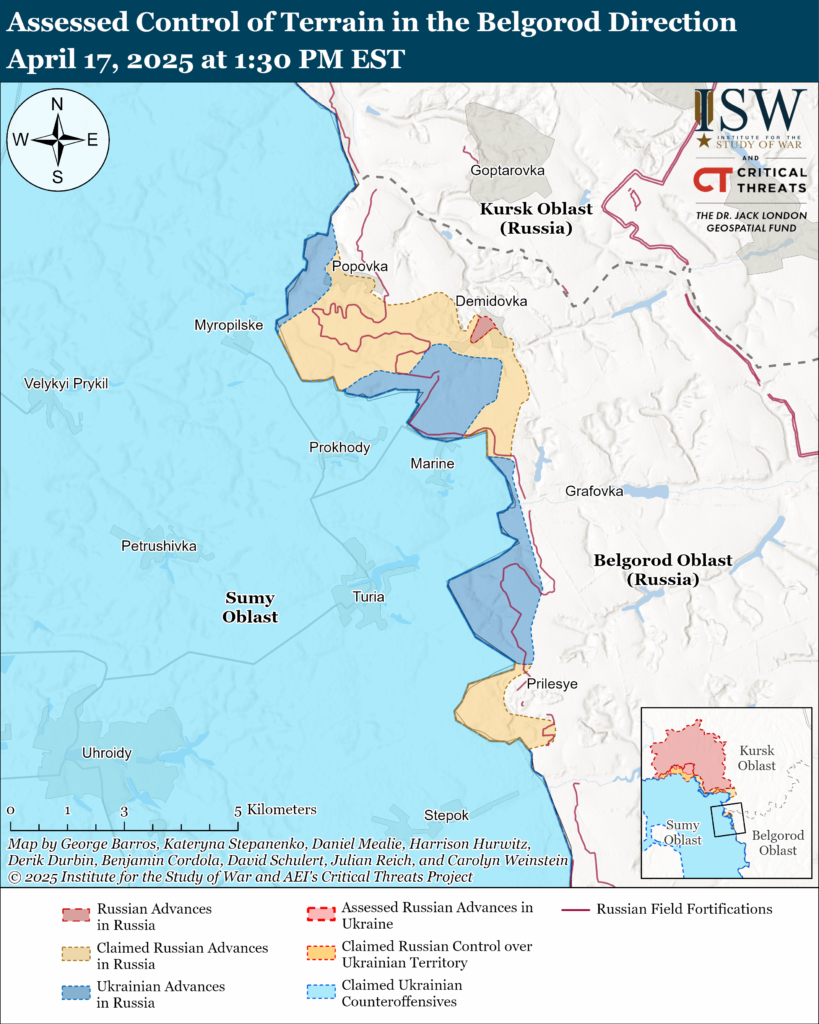
Ukrainian forces struck the base of a Russian missile brigade in Ivanovo Oblast for a second consecutive day. Geolocated footage published on April 17 indicates that Ukrainian drones struck the Russian 112th Missile Brigade (1st Guards Tank Army [GTA], Moscow Military District [MMD]) in Shuya, Ivanovo Oblast.[43] Russian sources claimed that Ukrainian forces targeted the base again overnight on April 16 to 17 after Ukrainian forces struck the base on April 16.[44] A Russian milblogger claimed that Ukrainian forces targeted the brigade’s administrative buildings on April 16 but targeted the brigade’s warehouses and technological infrastructure on the night of April 16 to 17.[45] The Ivanovo Oblast government reported on April 17 that Russian forces repelled a Ukrainian drone strike against Shuya, but that houses sustained damage, while the Russian Ministry of Defense (MoD) did not report any Ukrainian drone strikes against Ivanovo Oblast on the night of April 16 to 17.[46]
Russian Supporting Effort — Northern Axis (Russian objective: Create defensible buffer zones in northern Ukraine along the international border and approach to within tube artillery range of Sumy City)
Russian forces continued ground assaults in Sumy Oblast on April 17 but did not make confirmed advances.
Unconfirmed claims: Ukrainian military observer Kostyantyn Mashovets stated that Ukrainian forces advanced on the southern outskirts of Basivka (northeast of Bilovody).[47] A Russian milblogger claimed that Russian forces advanced in northern Bilovody (northeast of Sumy City).[48]
Fighting continued north of Yunakivka (southeast of Bilovody).[49]
Mashovets stated that Russian redeployments from the Kursk direction to other unspecified sectors of the front are slowing Russian efforts to create a buffer zone in Sumy Oblast.[50] Mashovets stated that Ukrainian forces pushed Russian forces back north of Bilovody and prevented Russian attempts to seize heights near Yunakivka.[51]
Order of Battle: Mashovets stated that elements of the Russian 83rd Airborne (VDV) Brigade and 76th VDV Division are operating in the Bilovody direction and that elements of the 106th VDV Division are operating in the Basivka direction.[52]
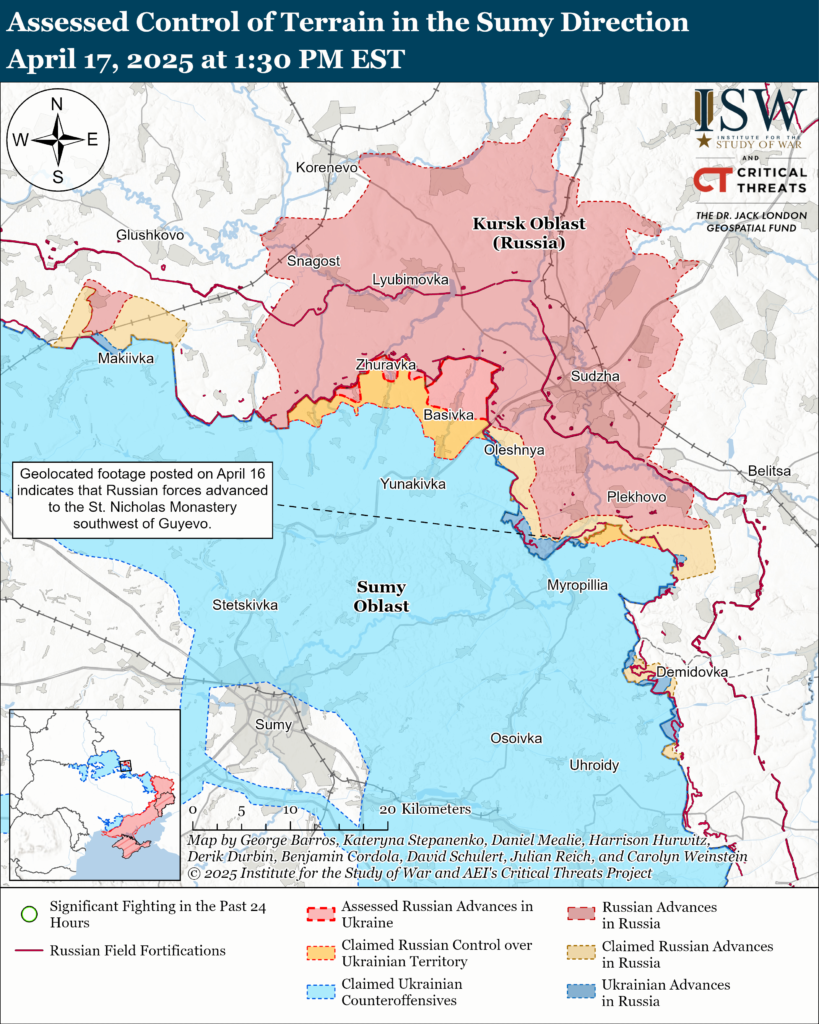
Russian Main Effort — Eastern Ukraine
Russian Subordinate Main Effort #1 — Kharkiv Oblast (Russian objective: Push Ukrainian forces back from the international border with Belgorod Oblast and approach to within tube artillery range of Kharkiv City)
Russian forces conducted limited offensive operations in northern Kharkiv Oblast on April 17 but did not make confirmed advances.
Unconfirmed claims: A Russian milblogger claimed on April 17 that Russian forces advanced 200 meters in Vovchansk (northeast of Kharkiv City).[53]
Russian forces continued ground attacks northeast of Kharkiv City near Vovchansk on April 16 and 17.[54] Russian sources claimed on April 17 that Ukrainian forces counterattacked near Vovchansk.[55]
Russian Subordinate Main Effort #2 — Luhansk Oblast (Russian objective: Capture the remainder of Luhansk Oblast and push westward into eastern Kharkiv Oblast and northern Donetsk Oblast)

Russian forces recently advanced in the Kupyansk direction.
Assessed Russian advances: Geolocated footage published on April 17 indicates that Russian forces recently advanced east of Kamyanka (northeast of Kupyansk near the international border).[56]
Unconfirmed claims: A Russian milblogger claimed that elements of the Russian 27th Separate Motorized Rifle Brigade (1st Guards Tank Army [GTA], Moscow Military District [MMD]) advanced across the P-79 Kupyansk-Dvorichna highway west of Zapadne (north of Kupyansk).[57]
Russian forces conducted ground attacks north of Kupyansk near Zapadne and east of Kupyansk near Petropavlivka on April 16 and 17.[58]
Order of Battle: Ukrainian military observer Kostyantyn Mashovets stated on April 17 that elements of the Russian 27th Separate Motorized Rifle Brigade are attacking toward Kindrashivka (north of Kupyansk) and Doroshivka (northwest of Zapadne).[59] Drone operators of the 352nd Motorized Rifle Regiment (11th Army Corps [AC], Leningrad Military District [LMD]) and elements of the “Kontora” Detachment (375th Separate Anti-Tank Artillery Battalion, 47th Tank Division, 1st GTA) are reportedly operating in the Kupyansk direction.[60]

Russian forces continued offensive operations in the Borova direction on April 17 but did not advance.
Unconfirmed claims: Mashovets reported that Ukrainian forces counterattacked east of Zahryzove (northeast of Borova) and advanced roughly one kilometer.[61]
Russian forces attacked northeast of Borova near Zahryzove, Bohuslavka, and Nova Kruhlyakivka; east of Borova near Nadiya; and southeast of Borova near Novoserhiivka and Hrekivka and toward Olhivka on April 16 and 17.[62]
Order of Battle: Mashovets stated on April 17 that elements of the Russian 2nd Motorized Rifle Division (1st GTA, MMD) are operating near Kruhlyakivka.[63]
Russian forces continued offensive operations in the Lyman direction on April 17 but did not make confirmed advances.
Unconfirmed claims: A Russian milblogger claimed on April 17 that Russian forces advanced west of Yampolivka (northeast of Lyman).[64] Mashovets reported that elements of the Russian 144th Motorized Rifle Division (20th CAA, MMD) advanced roughly 1.1 to 1.2 kilometers to the southern outskirts of Novomykhailivka (northeast of Lyman) between April 15 and 17.[65]
Russian forces conducted ground attacks northeast of Lyman near Novomykhailivka, Nove, Myrne, and Yampolivka and toward Zelena Dolyna and east of Lyman near Torske on April 16 and 17.[66]
Order of Battle: Mashovets stated that elements of the Russian 67th Motorized Rifle Division and 169th and 164th motorized rifle brigades (all of the 25th CAA, Central Military District [CMD]) are operating south of Yampolivka.[67] Tank elements of the Russian 164th Motorized Rifle Brigade are reportedly operating near Kreminna (east of Lyman in the Russian near rear).[68]
Russian Subordinate Main Effort #3 — Donetsk Oblast (Russian objective: Capture the entirety of Donetsk Oblast, the claimed territory of Russia’s proxies in Donbas, and possibly advance into Dnipropetrovsk Oblast)
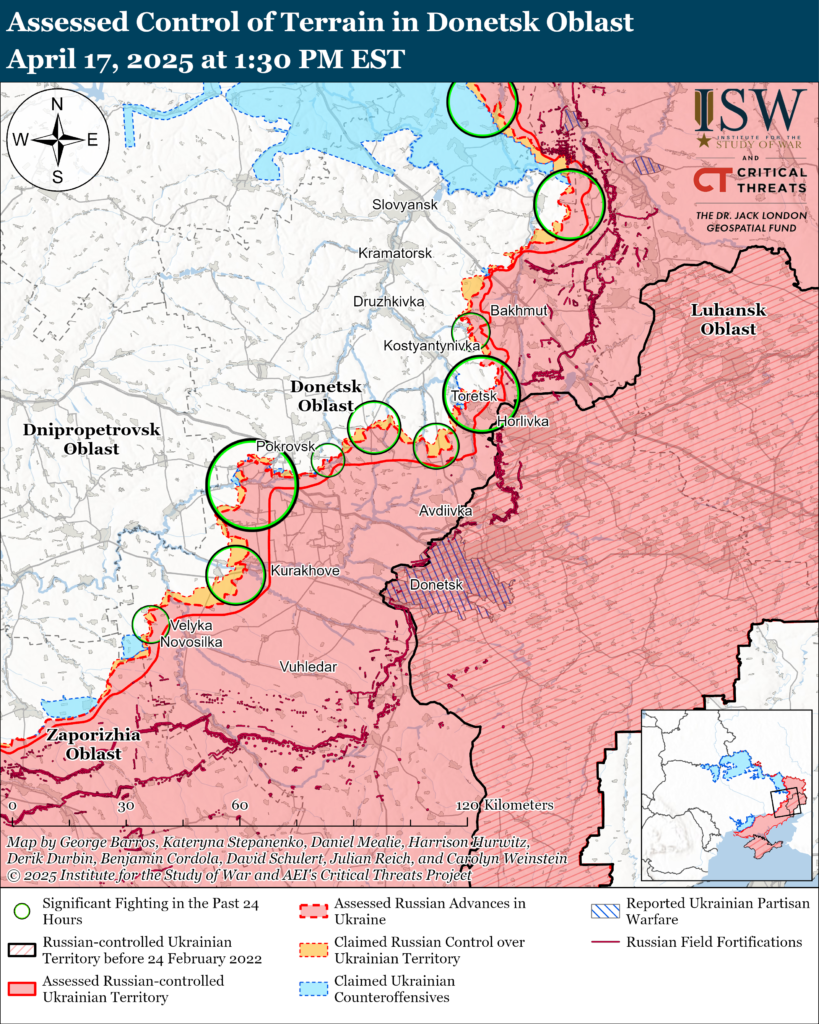
Russian forces continued offensive operations in the Siversk direction on April 17 but did not advance.
Russian forces conducted ground assaults northeast of Siversk near Hryhorivka, east of Siversk near Verkhnokamyanske, and southeast of Siversk near Ivano-Darivka and Vyimka on April 16 and 17.[69]
A Russian milblogger claimed that Verkhnokamyanske is a contested “gray zone.”[70]
Order of Battle: Elements of the Russian 127th Motorized Rifle Division (5th Combined Arms Army [CAA], Eastern Military District [EMD]) are reportedly operating near Bilohorivka (northeast of Siversk).[71]
Russian forces continued offensive operations in the Chasiv Yar direction on April 17 but did not advance.
Russian forces conducted offensive operations near Chasiv Yar itself, south of Chasiv Yar near Ozaryanivka and toward Stupochky, and southeast of Chasiv Yar near Kurdyumivka on April 16 and 17.[72]
Order of Battle: Elements of the Russian 217th Airborne (VDV) Regiment (98th VDV Division) are reportedly operating near Chasiv Yar.[73]
Ukrainian and Russian forces recently advanced in the Toretsk direction.
Assessed Ukrainian advances: Geolocated footage published on April 16 indicates that Ukrainian forces recently advanced in western Druzhba (northeast of Toretsk).[74]
Assessed Russian advances: Geolocated footage published on April 16 and 17 indicates that Russian forces recently advanced in northern and northwestern Toretsk and in the Novotoretska mine northwest of Torestk.[75]
Unconfirmed claims: A Russian milblogger claimed that Russian forces seized Sukha Balka (southwest of Toretsk and east of Pokrovsk).[76] Russian milbloggers claimed that Russian forces advanced northwest of Valentynivka (southwest of Sukha Balka), near Panteleymonivka (southeast of Valentynivka), and one kilometer along the H-20 Donetsk City-Kostyantynivka highway west of Oleksandropil (south of Panteleymonivka).[77]
Russian forces conducted offensive operations near Toretsk itself; northeast of Toretsk near Dachne, Druzhba, and Dyliivka; west of Toretsk near Leonidivka; and southwest of Toretsk near Sukha Balka and Valentynivka on April 16 and 17.[78] A Russian milblogger claimed that Ukrainian forces counterattacked on the outskirts of Toretsk.[79]
The spokesperson of a Ukrainian brigade operating in the Toretsk direction reported that Russian forces continue conducting constant mechanized and infantry assaults and are using armored vehicles to deliver infantry as close as possible to the frontline.[80] The spokesperson noted that Russian forces unprecedented number of drones in the area and that Russian mechanized assaults include vehicles with “all possible electronic warfare (EW) equipment” and a lead vehicle with a mine trawl.
Order of Battle: Elements of the Russian 242nd Motorized Rifle Regiment (20th Motorized Rifle Division, 8th CAA, Southern Military District [SMD]) and the 68th Tank Regiment (150th Motorized Rifle Division, 8th CAA) are reportedly operating near the H-20 Donetsk City-Kostyantynivka highway west of Oleksandropil.[81] Drone operators of the Russian 102nd and 103rd motorized rifle regiments (both of the 150th Motorized Rifle Division) are reportedly operating near Shcherbynivka (west of Toretsk).[82] Elements of the 4th Motorized Rifle Brigade (3rd CAA, formerly 2nd Luhansk People’s Republic Army Corps [LNR AC], SMD) are reportedly operating near Druzhba.[83]
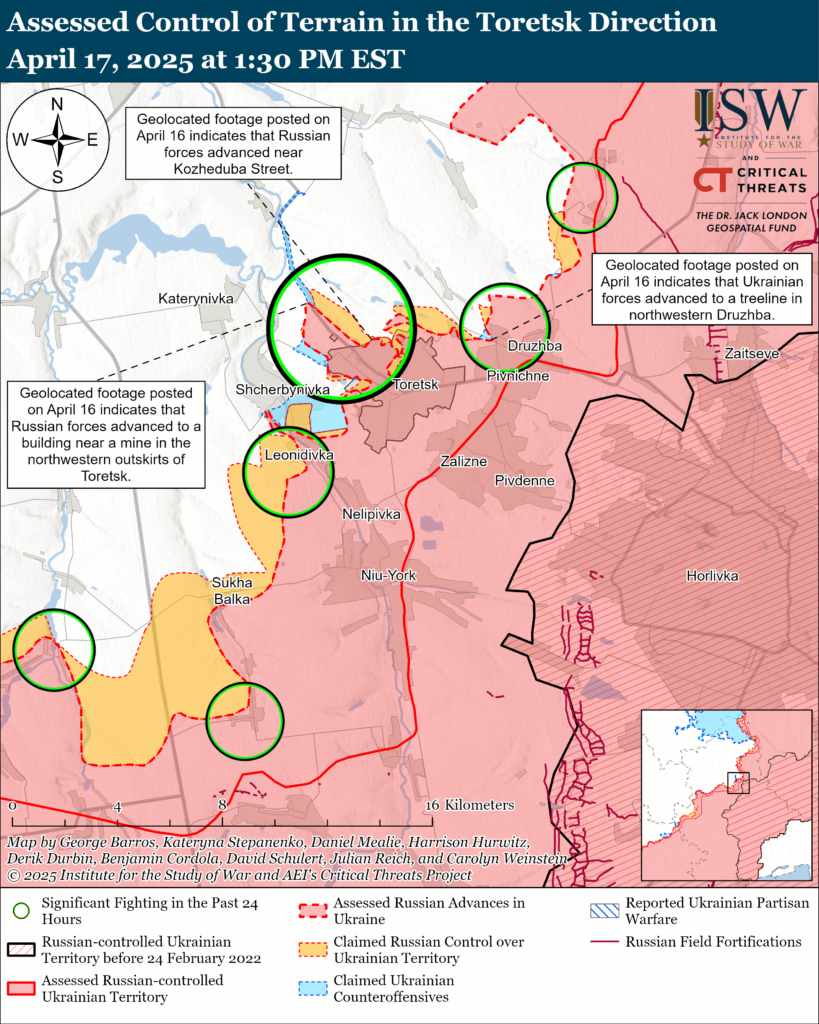
Russian forces recently advanced in the Pokrovsk direction.
Assessed Russian advances: Geolocated footage published on April 17 indicates that Russian forces recently advanced east of Myrolyubivka (east of Pokrovsk).[84]
Unconfirmed claims: A Russian milblogger claimed that Russian forces advanced to southwestern Myrolyubivka, west and east of Kalynove (east of Pokrovsk), and northeast of Kotlyne (southwest of Pokrovsk).[85]
Russian forces attacked east of Pokrovsk near Myrolyubivka, Stara Mykolaivka, Zelene Pole, Vodyane Druhe, Promin, Oleksandropil, Novotoretske, and Yelyzavetivka; southeast of Pokrovsk near Lysivka; south of Pokrovsk near Shevchenko and Zelene; and southwest of Pokrovsk near Zvirove, Pishchane, Novooleksandrivka, and Kotlyne on April 16 and 17.[86]
Order of Battle: The Russian Ministry of Defense (MoD) claimed that elements of the Russian 90th Tank Division (41st CAA, Central Military District [CMD]) are operating in the Pokrovsk direction.[87] Elements of the 242nd Motorized Rifle Regiment (20th Motorized Rifle Division, 8th CAA, SMD) are reportedly operating near Kalynove.[88]
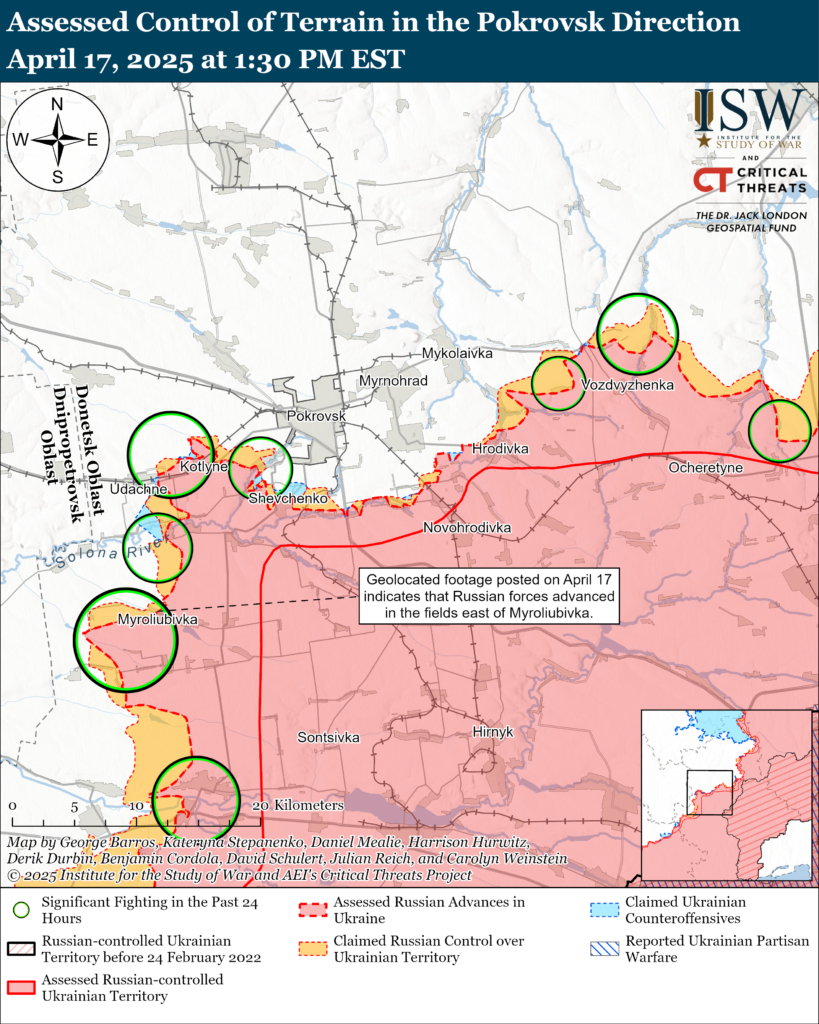
Russian forces recently advanced in the Novopavlivka direction.
Assessed Russian advances: Geolocated footage published on April 17 indicates that Russian forces recently advanced into northern Nadiivka (east of Novopavlivka).[89]
Unconfirmed claims: A Russian milblogger claimed on April 16 that Ukrainian forces advanced in Uspenivka (northeast of Novopavlivka).[90] A Russian milblogger claimed that Russian forces advanced in central Kotlyarivka (east of Novopavlivka) and north of Troitske (southeast of Novopavlivka).[91]
Russian forces attacked northeast of Novopavlivka near Uspenivka, east of Novopavlivka near Preobrazhenka and Troitske, and southeast of Novopavlivka near Bohdanivka on April 16 and 17.[92]
The Russian MoD claimed on April 17 that Russian forces seized Preobrazhenka (southeast of Novopavlivka), but ISW assesses that Russian forces seized the settlement as of March 29.[93]
Order of Battle: Elements of the Russian 506th Motorized Rifle Regiment (27th Motorized Rifle Division, 2nd CAA, CMD) are reportedly operating near Uspenivka.[94]
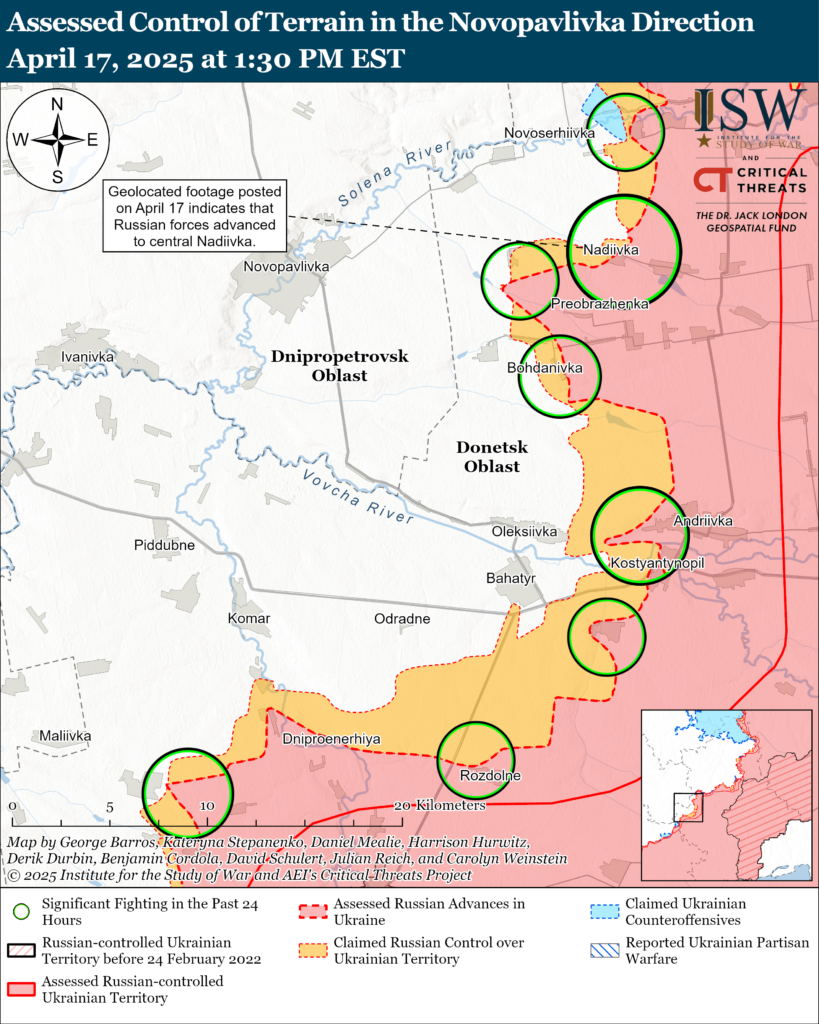
Russian forces continued offensive operations in the Kurakhove direction on April 17 but did not make any confirmed advances.
Unconfirmed claims: Russian milbloggers claimed that Russian forces advanced on the eastern outskirts of Bahatyr (southwest of Kurakhove), 300 meters toward Bahatyr from Rozdolne (south of Bahatyr), and near Odradne (southwest of Bahatyr).[95]
Russian forces attacked west of Kurakhove near Kostyantynopil and Andriivka and southwest of Kurakhove near Rozlyv and Bahatyr on April 16 and 17.[96] A Russian milblogger claimed that Ukrainian forces counterattacked south of Odradne.[97]
Order of Battle: Drone operators of the Russian 4th Motorized Rifle Brigade (3rd CAA, SMD) and the 174th Separate Reconnaissance Battalion (150th Motorized Rifle Division, 8th CAA, SMD) are reportedly striking Ukrainian forces operating near Dachne (northwest of Kostyantynopil in Dnipropetrovsk Oblast).[98] Drone operators of the Russian 14th Spetsnaz Brigade (Russian General Staff’s Main Directorate [GRU]) and 11th Air Force and Air Defense Army (Russian Aerospace Forces [VKS] and EMD) are reportedly operating near Bahatyr and Odradne.[99]
Russian forces recently advanced in the Velyka Novosilka direction.
Assessed Russian advances: Geolocated footage published on April 17 indicates that Russian forces recently marginally advanced southeast of Dniproenerhiya (north of Velyka Novosilka).[100]
Russian forces attacked west of Velyka Novosilka near Pryvilne on April 17.[101] Russian milbloggers claimed that Ukrainian forces counterattacked near Dniproenerhiya and Vesele (northwest of Dniproenerhiya).[102]
Russian Supporting Effort — Southern Axis (Russian objective: Maintain frontline positions, secure rear areas against Ukrainian strikes, and advance within tube artillery range of Zaporizhzhia City)
Russian forces recently advanced in western Zaporizhia Oblast.
Assessed Russian advances: Geolocated footage published on April 17 indicates that elements of the Russian 58th Combined Arms Army (CAA) (Southern Military District [SMD]) recently advanced along the T-0815 Orikhiv-Polohy highway south of Mala Tokmachka (southeast of Orikhiv) during a battalion-sized mechanized assault on a broad front south and southwest of Orikhiv on April 16.[103]
See topline text for updates on the Russian battalion-sized mechanized assault in western Zaporizhia Oblast.
Russian forces continued ground assaults southeast of Orikhiv near Mala Tokmachka and southwest of Orikhiv near Lobkove, Novodanylivka, Stepove, Kamyanske, Shcherbaky, and Mali Shcherbaky on April 16 and 17.[104]
Ukraine’s Southern Operational Command reported that Ukrainian forces recently destroyed a radar station of a Russian Buk-M3 air defense system in an unspecified location in southern Ukraine.[105]
Order of Battle: Drone operators of the “Nemets” group of the 291st Motorized Rifle Regiment (42nd Motorized Rifle Division, 58th CAA), 22nd Spetsnaz Brigade (Russian General Staff’s Main Directorate [GRU]), and 7th Airborne (VDV) Division reportedly continue operating in the Zaporizhia direction.[106]
Russian forces continued limited ground attacks in the Dnipro direction on April 16 and 17 but did not advance.[107]
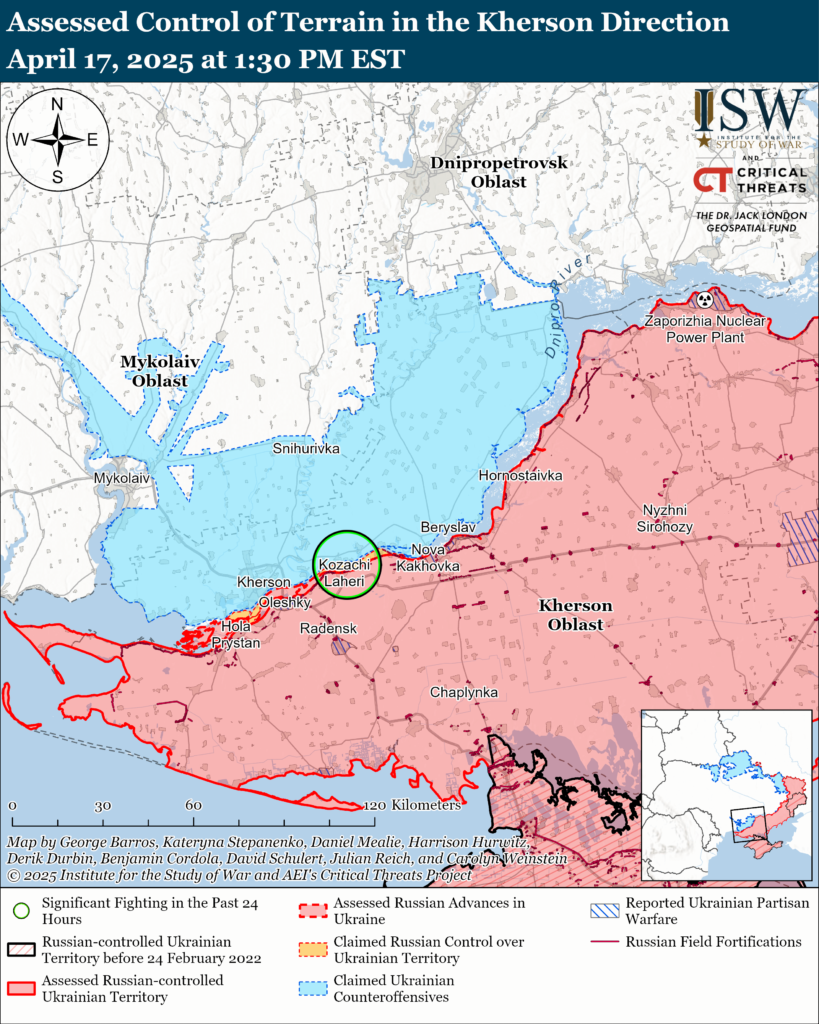
Russian Air, Missile, and Drone Campaign (Russian Objective: Target Ukrainian military and civilian infrastructure in the rear and on the frontline)
Russian forces conducted a series of missile and drone strikes against Ukraine overnight on April 15 to 16. The Ukrainian Air Force reported that Russian forces launched two Iskander-M ballistic missiles from Rostov Oblast; three S-300/400 air defense missiles from occupied Luhansk Oblast; and 75 Shahed and decoy drones from the directions of Kursk City; Millerovo, Rostov Oblast; and occupied Cape Chauda, Crimea.[108] The Ukrainian Air Force reported that Ukrainian forces downed 25 drones over northern, eastern, southern, and central Ukraine and that 30 decoy drones were “lost,” likely due to Ukrainian electronic warfare (EW) interference. Ukrainian officials reported that drones struck Odesa City and Sumy Oblast and that ballistic missiles struck infrastructure in Kharkiv and Donetsk oblasts.[109] Kharkiv Oblast Military Administration Head Oleh Synehubov reported that Russian forces launched a large drone and missile strike against Izyum, Kharkiv Oblast, damaging six houses and injuring six people.[110] Ukrainian officials reported that Russian forces launched a large drone strike against houses and civilian infrastructure in Dnipro City, Dnipropetrovsk Oblast, killing three people and injuring 28, including four children.[111]
Russian Mobilization and Force Generation Efforts (Russian objective: Expand combat power without conducting general mobilization)
ISW is suspending Russian technological adaptations coverage in its daily Russian Offensive Campaign Assessments. ISW is introducing a new product line tracking Russian mobilization, force generation efforts, and technological adaptations. Click here to read the Russian Force Generation and Adaptations Update.
Russian Technological Adaptations (Russian objective: Introduce technological innovations to optimize systems for use in Ukraine)
ISW is suspending Russian technological adaptations coverage in its daily Russian Offensive Campaign Assessments. ISW is introducing a new product line tracking Russian mobilization, force generation efforts, and technological adaptations. Click here to read the Russian Force Generation and Adaptations Update.
Activities in Russian-occupied areas (Russian objective: Consolidate administrative control of annexed areas; forcibly integrate Ukrainian citizens into Russian sociocultural, economic, military, and governance systems)
ISW is suspending occupation coverage in its daily Russian Offensive Campaign Assessments. ISW is introducing a new product line tracking activities in Russian-occupied areas of Ukraine. The occupation updates will examine Russian efforts to consolidate administrative control of annexed areas and forcibly integrate Ukrainian citizens into Russian sociocultural, economic, military, and governance systems. Click here to read the Russian Occupation Update.
Significant activity in Belarus (Russian efforts to increase its military presence in Belarus and further integrate Belarus into Russian-favorable frameworks)
Nothing significant to report.
Note: ISW does not receive any classified material from any source, uses only publicly available information, and draws extensively on Russian, Ukrainian, and Western reporting and social media as well as commercially available satellite imagery and other geospatial data as the basis for these reports. References to all sources used are provided in the endnotes of each update.
 Eurasia Press & News
Eurasia Press & News
